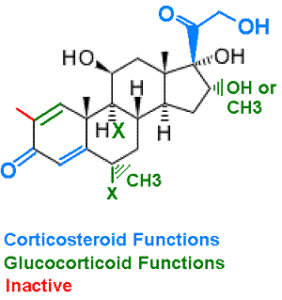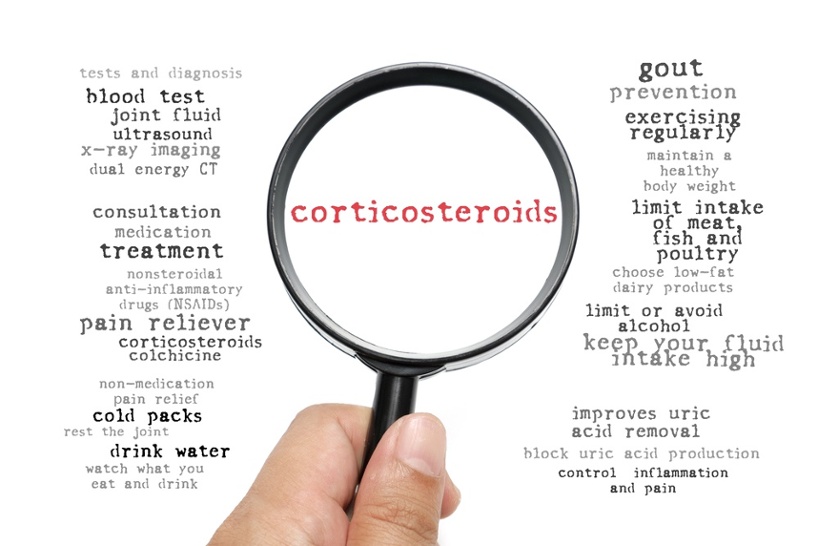- What are systemic corticosteroids and how do they work?

Corticosteroids are steroid hormones that are either produced by the body or are man-made.
Systemic corticosteroids refer to corticosteroids that are given orally or by injection and distribute throughout the body. It does not include corticosteroids used in the eyes, ears, or nose, on the skin or that are inhaled, although small amounts of these corticosteroids can be absorbed into the body.
Naturally occurring corticosteroids, hydrocortisone (Cortef) and cortisone, are produced by the outer portion of the adrenal gland known as the cortex (hence the name, corticosteroid). Corticosteroids are classified as either:
- glucocorticoids (anti-inflammatory) which suppress inflammation and immunity and assist in the breakdown of fats, carbohydrates, and proteins, or as
- mineralocorticoids (salt retaining) that regulate the balance of salt and water in the body.
Synthetic corticosteroids mimic the actions of naturally occurring corticosteroids and may be used to replace corticosteroids in people with adrenal glands that are unable to produce adequate amounts of corticosteroids, however, they more often are used in higher-than-replacement doses to treat diseases of immunity, inflammation or salt and water balance.
Examples of synthetic corticosteroids include:
- bethamethasone, (Celestone)
- prednisone (Prednisone Intensol)
- prednisolone (Orapred, Prelone)
- triamcinolone (Aristospan Intra-Articular, Aristospan Intralesional, Kenalog)
- methylprednisolone (Medrol, Depo-Medrol, Solu-Medrol)
- dexamethasone (Dexamethasone Intensol, DexPak 10 Day, DexPak 13 Day, DexPak 6 Day).
Some glucocorticoids also in addition to their anti-inflammatory actions have salt retaining properties but they are used mostly for their anti-inflammatory effects. Fludrocortisone (Florinef), a synthetic mineralocorticoid has strong salt retaining effects with significant anti-inflammatory actions, and is used mostly for it’s salt retaining capabilities.
What are some examples of systemic (oral and injectable) corticosteroids?
 The following is a list of the systemic (oral and injectable) corticosteroids that are available in the United States:
The following is a list of the systemic (oral and injectable) corticosteroids that are available in the United States:
Glucocorticoids:
- hydrocortisone (Cortef)
- cortisone
- ethamethasoneb (Celestone)
- prednisone (Prednisone Intensol)
- prednisolone (Orapred, Prelone)
- triamcinolone (Aristospan Intra-Articular, Aristospan Intralesional, Kenalog) Methylprednisolone (Medrol, Depo-Medrol, Solu-Medrol)
- dexamethasone (Dexamethasone Intensol, DexPak 10 Day, DexPak 13 Day, DexPak 6 Day)
Mineralocorticoid:
- Fludrocortisone (Florinef)
For what conditions are systemic corticosteroids used?
Corticosteroids belonging to the glucocorticoidclass influence the body system in several ways, but they are used mostly for their strong anti-inflammatory effects and in conditions that are related to the immune system function such as:
- arthritis (for example, rheumatoid arthritis),
- colitis (ulcerative colitis, and Crohn’s disease),
- asthma,
- bronchitis,
- some situations involving skin rashes,
- allergic or inflammatory conditions involving the nose and eyes.
Glucocorticoid corticosteroids are used to treat systemic lupus, severe psoriasis, leukemia, lymphomas, idiopathic thrombocytopenic purpura, and autoimmune hemolytic anemia. These corticosteroids also are used to suppress the immune system and prevent rejection in people who have undergone organ transplant as well as many other conditions.
Fludrocortisone (Florinef), a potent systemic oral mineralocorticoid corticosteroid is used to treat Addison’s disease and diseases that cause salt loss as in congenital adrenal hyperplasia. It also is used commonly to treat conditions of low blood pressure (hypotension) although this is not a Food and Drug Administration (FDA) approved indication.
Are there any differences among the different types of systemic corticosteroids?
Corticosteroids differ in their relative amount of anti-inflammatory and mineralocorticoid potency and they are used according to these effects. Among the systemic (oral and injectable) corticosteroids, fludrocortisone (Florinef) has the most significant mineralocorticoid (salt retaining) actions and is best used for this effect despite it’s strong anti-inflammatory action.
Other systemically available corticosteroids have mostly glucocorticoid effects, and are used for their anti-inflammatory activities. Examples of these include the naturally occurring hydrocortisone (Cortef) and cortisone, and the synthetic corticosteroids including:
- bethamethasone (Celestone)
- prednisone (Prednisone Intensol)
- prednisolone (Orapred, Prelone)
- triamcinolone (Aristospan Intra-Articular, Aristospan Intralesional, Kenalog)
- methylprednisolone((Medrol, Depo-Medrol, Solu-Medrol)
- dexamethasone (Dexamethasone Intensol, DexPak 10 Day, DexPak 13 Day, DexPak 6 Day).
Among all glucocorticoids, prednisone is not effective in the body unless it is converted to prednisolone by enzymes in the liver. For this reason prednisone may not be very effective in people with liver disease because of a reduction in their ability to convert prednisone to prednisolone.
What are the side effects of systemic corticosteroids?
Corticosteroids have many side effects that can be mild or serious. These side effects are more apparent when corticosteroids are used at higher doses or for extended periods of time. This section lists only some of these side effects of corticosteroids.
Corticosteroids can:
- cause sodium (salt) and fluid to be retained in the body and cause weight gain or swelling of the legs (edema)
- High blood pressure
- Loss of potassium
- Headache
- Muscle weakness
- Puffiness of the face (moon face)
- Facial hair growth
- Thinning and easy bruising of the skin
- Slow wound healing
- Glaucoma
- Cataracts
- Ulcers in the stomach and duodenum
- Loss of diabetes control
- Menstrual irregularity
- “Buffalo hump,” a condition described as a rounding of the upper back
The prolonged use of corticosteroids can cause obesity, growth retardation in children, and even lead to convulsions and psychiatric disturbances. Reported psychiatric disturbances include depression, euphoria, insomnia, mood swings, and personality changes. Psychotic behaviors also have been reported.
Corticosteroids, since they suppress the immune system, can lead to an increase in the rate of infections and reduce the effectiveness of vaccines and antibiotics.
The long term use of corticosteroids may cause osteoporosis which can result in bone fractures.
Shrinking (atrophy) of the adrenal glands can be caused by the long term use of corticosteroids resulting in the body’s inability to produce cortisol, the body’s natural corticosteroid, when the systemic corticosteroids are discontinued.
Another condition which can result from the long term use of corticosteroids is adrenal necrosis of the hip joints, a very painful and serious condition that may require surgery. Any symptoms of hip or knee pain in people taking corticosteroids require prompt medical attention.
Corticosteroids should not be stopped suddenly after prolonged use as this can result in adrenal crisis because of the body’s inability to secrete enough cortisol to make up for the withdrawal. Nausea, vomiting, and shock are the reported side effects of adrenal crisis.
With which drugs do systemic (oral and injectable) corticosteroids interact?
Certain drugs such as troleandomycin (TAO), erythromycin (Ery-Tab, EryPed 200), and clarithromycin (Biaxin) and ketoconazole (Nizoral) can reduce the ability of the liver to metabolize (breakdown) corticosteroids and this may lead to an increase in the levels and side effects of corticosteroids in the body. On the other hand, phenobarbital, ephedrine, phenytoin (Dilantin), and rifampin (Rifadin, Rimactane) may reduce the blood levels of corticosteroids by increasing the breakdown of corticosteroids by the liver. This may necessitate an increase of corticosteroid dose when they are used in combination with these drugs.
Estrogens have been shown to increase the effects of corticosteroids possibly by decreasing their breakdown by the liver.
Corticosteroid effects on warfarin (Coumadin) can vary; therefore when taking warfarin (Coumadin) along with corticosteroids, there may be increased need for monitoring coagulation levels more closely.
Low blood potassium (hypokalemia) and a higher chance of heart failure can result from combining corticosteroids with drugs that reduce potassium in the blood (for example, diuretics, amphotericin B).
Anticholinesterase drugs (for example, physostigmine) may cause severe weakness in some patients with myasthenia gravis when prescribed with corticosteroids.
Corticosteroids can increase blood glucose, so close monitoring of blood sugar and higher doses of diabetes medications may be needed.
Cholestyramine (Questran, Questran Light) can decrease the absorption of oral corticosteroids from the stomach and this could reduce the blood levels of corticosteroids.

